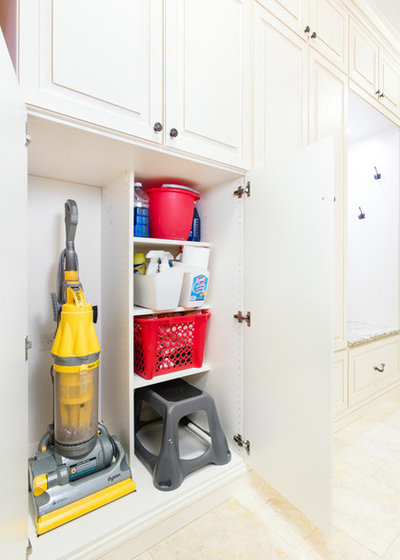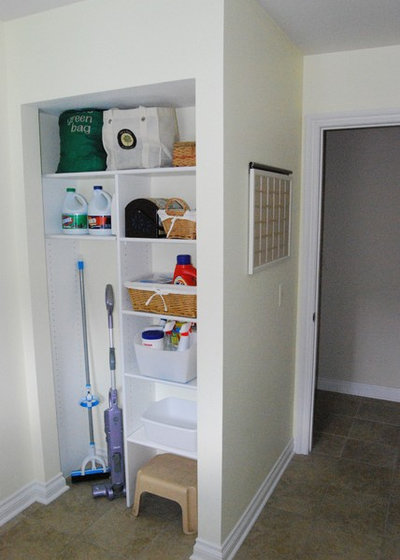How to Choose the Right Vacuum
Upright or canister, for wood floors or carpet: These are just some of the things to consider when choosing a vacuum
We all have friends who tell us they’ve found the perfect vacuum. But you should realize that your friend’s ideal appliance may not be the perfect one for you. Everyone has different preferences and different homes. Let’s take a look at some of the different kinds of flooring used today and which type of vacuums work best for them. It should help you find the right type for both you and your home.
Types of Vacuums
Upright vacuums. There are many reasons that some people prefer upright vacuums to canister vacuums. On average, uprights tend to be cheaper than canister vacuum cleaners. They also tend to have a wider cleaning path, which means less back and forth. And they are easier to store because there are no accessories to dismount and put away.
Browse upright vacuums
Canister vacuums. A good quality canister vacuum is very versatile. It generally will have numerous attachments so you can clean wall-to-wall carpets, area rugs and hardwood floors. Canister vacuums also tend to be lighter than uprights and therefore easier to handle.
Some people don’t like canisters, however, because their path is a little harder to control, and they may flip over while you are pulling them. Look for a canister that’s not too top-heavy, and feel free to test it out at the store.
Broom vacs. Small broom vacs are convenient for quick spills or a light cleaning. They are not designed to be used for regular cleaning or dealing with pet hair. It’s a great tool to have in the kitchen or bathroom.
Central vacuums. Central vacuums are a popular feature in Canadian homes. The main unit, usually housed in the basement, is connected through tubes to various ports throughout the house. A standard 35-foot-long hose with attachments can be connected to these various ports.
A central vac system is definitely an investment, but the average system lasts for 20 years and adds resale value to your home. The kickplate feature of a central vacuum is also a big plus for your body: You can turn your vacuum on with your toe and sweep spills away without having to bend over.
The more the merrier. Since many homes have more than one type of flooring, it may be wise to have more than one type of vacuum. Whether it’s a handheld vac for small cleanups, a shop vac for cleaning up the garage or some combination of a canister, upright or broom vac for your other cleaning situations, owning multiple vacuums may be the way to go to cover your home’s entire cleaning needs.
Types of Flooring
Wood floors. Wood floors look beautiful, but the space between each plank is a magnet for collecting dust and dirt. To clean down inside those crevices, you will need a vacuum with very strong suction. Suction is measured by water lift. Most manufacturers have that rating on the vacuum itself. You want to look for a rating of over 100 air-watts to ensure good suction.
Wood floors are best cleaned with a high-quality canister vacuum with a horsehair floor brush to limit scratches. Some canisters have power heads that can be turned off with a flip of a switch so you can go directly from carpet to hard floors.
Thick carpets and area rugs. Thick carpets like the one in this picture really can’t be vacuumed correctly with either an upright or a canister vacuum. This carpet would have to be picked up and shaken out before attempting to vacuum it. Thick carpets and rugs in general need a quality vacuum with an electric power head and strong suction. However, it’s important to have thick rugs and carpets professionally steam cleaned at least once a year.
Low pile carpets and area rugs. These types of carpets and rugs are easy to keep clean with a vacuum that has a beater bar attachment, which is a specialized rotating brush also known as a power or turbo brush that stirs debris from the bottom of the carpeting so the suction can whisk it away. A beater bar usually comes with an upright or a canister vacuum.
Delicate area rugs. Many antique area rugs need special care. They should be cleaned gently with an air-driven power head or with a floor brush and straight suction.
Pro tip: If you have pet hair that is difficult to remove, try wiping a rubber glove over the carpet. It will create static and pull the hair off the carpet.
Tile floors. Tile floors are easy to clean with a hose and a floor brush. I personally don’t recommend using an upright with a power brush on the tile. The wheels on the upright can leave black scuff marks on the tile, and the spinning brush roll may spit out as much dirt as it sucks up.
Carpeted stairs. If you have carpeted stairs, you should consider the weight and style of your vacuum. Climbing a staircase with a heavy upright vacuum can be dangerous. Even a large canister that doesn’t fit on an individual step can fall down the stairs and do some real damage. Therefore, a lightweight vacuum or broom vac is ideal for carpeted stairs.
Wood stairs. A quick way to clean wood stairs is to use the upholstery attachment on your vacuum and “dust” the stairs. You can do this with a canister vacuum by holding the main vacuum in one hand and the dusting tool in the other. Adding an extension cord to your vacuum will help get all the way up the stairs without having to unplug it.















